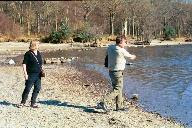Wake to our daylight view of the pyramids, now majestic in the sun, and we can see buses already arriving in front of them. Downstairs for breakfast. It's a bit depressing. Nothing's really all that clean and we know better thaqn to eat salads in Egypt. There's a reasonable variety of white buns and sweet buns, most looking a bit dry. We take cups (choosing the cleanest) of fairly warm coffee and consider the options. J says he doesn't think he's up to the middle east breakfast at this hour of the morning but I want something to start the day's sightseeing with and decide that an advantage to the cooked dishes is that probably nobody has plynged a grubby hand into them. So back to take rice, foule (a standard mideast cooked bean dish) and a garlicky aubergine and onion mixture which has actually been kept fairly hot, as well as being delicious. J tries and is similarly impressed. And we switch to tea, which is hot.
Ayet, our guide for the day, arrives, a friendly young lady in a jean jacket, and we head for the pyramids, a short drive away. The only remaining wonder of the original 7 wonders of the world, so simple and yet so incredibly impressive. Ayet refers to limestone as the best of building materials, but only in such a dry climate would it have survived, and indeed over time the largest pyramid has gone from 146 metres to 137 in height over the past 4500 or so years.
We see the Sphinx, but decline the perfume factory tour, although Ayet points out it's included in our package. Ditto the papyrus making demo, which we agree is very interesting but something we have seen before. This buys us more time at the museum, and J persuades Ayet to forgo the explanations of other exhibits so that we can spend all our time with King Tut's treasures. It's all interesting, from amulets to a hinged, folding camp bed used by the boy king on hunting trips.
The best of it is astonishing. There's the well known death mask, with its eleven kilos of gold and the classic symmetrical face, and the coffins, which fit together like a Russian doll. Two of the three, made of solid gold, are on display, as are the gold inlaid nesting containers they fit inside, each bigger than the last, and the largest one enormous. The most moving of the King Tut exhibits, though, is the throne. It's a gold chair of moderate size, but its back panel has a coloured bas relief of a teenaged King Tut and his young wife, unique in its intimate and informal portrayal of affection. The two have eyes only for each other. He is seated comfortably and she is standing, rubbing his arm with oil. Each wears only one sandal of a pair, a unit only when they are together.
Ayet meets us outside King Tut's rooms by some mummies, calling our attention to one which includes a lock of hair, "given to him by a grandmother as a hair-loom," she tells us seriously. We head off across the city for the Islamic area. Driving in Cairo is not for the faint-hearted. Some streets are impossibly narrow but many are multi-lane, the lanes not always marked as cars four or five abreast fight for space, hands on horns and fenders showing signs of past wars. Most of the traffic is vehicular, but there is the odd cart pulled by a donkey and once we pass a wagon pulled by a donkey yoked with a horse. One would expect more accidents and there are many battle scars but we don't witness any prangs, though we once see a smashed car being carried on a small flatbed.
Ayet, who has sadly given up on us a source of extra tailor-made tours tomorrow, takes us to an outside cafe in a square beside the Sayyidina el-Hussein Mosque (apparently, according to the old Let's Go, the resting place of the skull of the grandson of Mohammed). It's a lovely sunlit spot where locals and tourists mix. As we arrive, a large man wearing shorts and a Hawaiian style shirt climbs into the front of a tourist bus and shouts to his wife "wrong bus!" Most tourists are less cliched looking though, and mix with locals. Ayet has guava juice while J and I drink tea with large sprigs of fresh mint immersed - very refreshing. There are sales attempts every few seconds - watches, jewellery, caps - but nothing too pressing. And we get a chance to chat with Ayet. She doesn't wear the hijab, but agrees most women do, though she says there's no pressure. She's learning Russian because there are increasing numbers of Russian tourists. The cafe is a lovely, cosmopolitan spot. Women walk past carrying large suitcase-sized bundles on their heads, the traditional load now wrapped in bright green plastic. Arabic and English are not the only languages in the air. As we leave, we see a tiny kitten curled under a table.
Back at the hotel we can still hear the traffic from our 10th floor room with the window closed.




